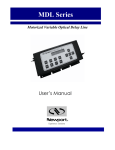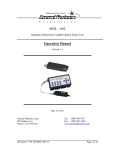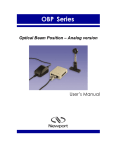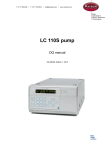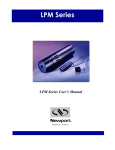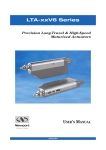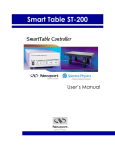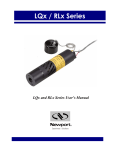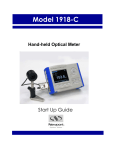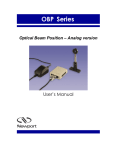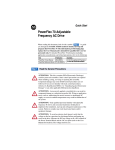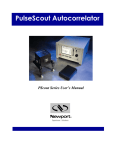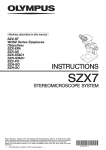Download MDL User Manual 41758A
Transcript
Motorized Delay Line MDL Series User’s Manual i Warranty Newport Corporation warrants that this product will be free from defects in material and workmanship and will comply with Newport’s published specifications at the time of sale for a period of one year from date of shipment. If found to be defective during the warranty period, the product will either be repaired or replaced at Newport's option. To exercise this warranty, write or call your local Newport office or representative, or contact Newport headquarters in Irvine, California. You will be given prompt assistance and return instructions. Send the product, freight prepaid, to the indicated service facility. Repairs will be made and the instrument returned freight prepaid. Repaired products are warranted for the remainder of the original warranty period or 90 days, whichever is longer. Limitation of Warranty The above warranties do not apply to products which have been repaired or modified without Newport’s written approval, or products subjected to unusual physical, thermal or electrical stress, improper installation, misuse, abuse, accident or negligence in use, storage, transportation or handling. This warranty also does not apply to fuses, batteries, or damage from battery leakage. THIS WARRANTY IS IN LIEU OF ALL OTHER WARRANTIES, EXPRESSED OR IMPLIED, INCLUDING ANY IMPLIED WARRANTY OF MERCHANTABILITY OR FITNESS FOR A PARTICULAR USE. NEWPORT CORPORATION SHALL NOT BE LIABLE FOR ANY INDIRECT, SPECIAL, OR CONSEQUENTIAL DAMAGES RESULTING FROM THE PURCHASE OR USE OF ITS PRODUCTS. First printing 2004 © 2004 by Newport Corporation, Irvine, CA. All rights reserved. No part of this manual may be reproduced or copied without the prior written approval of Newport Corporation. This manual has been provided for information only and product specifications are subject to change without notice. Any change will be reflected in future printings. Newport Corporation 1791 Deere Avenue Irvine, CA, 92606 USA P/N 41758-01 Rev. A ii EU Declaration of Conformity We declare that the accompanying product, identified with the mark, complies with requirements of the Electromagnetic Compatibility Directive, 89/336/EEC and the Low Voltage Directive 73/23/EEC. Model Number: F-MDL Series, a Variable Optical Delay Line Year mark affixed: 2004 Type of Equipment: Electrical equipment for measurement, control and laboratory use Standards Applied: Compliance was demonstrated to the following standards to the extent applicable: BS EN61326-1:1997+A1+A2 “Electrical equipment for measurement, control and laboratory use – EMC requirements” This equipment meets the Class B radiated and conducted emission limits. BS EN 61000-3-2:2001, Harmonic current emissions, Class A BS EN 61000-3-3:2002, Voltage fluctuations and flicker BS EN 61010-1:1993, A1+A2 “Safety requirements for electrical equipment for measurement, control and laboratory use” Alain Danielo VP European Operations Zone Industrielle 45340 Beaune-la-Rolande, France Dan Dunahay Director of Quality Systems 1791 Deere Avenue Irvine, Ca. USA iii Technical Support Contacts North America & Asia Europe Newport Corporation Service Dept. Newport/MICRO-CONTROLE S.A. 1791 Deere Ave. Irvine, CA 92606 Zone Industrielle Telephone: (949) 253-1694 45340 Beaune la Rolande, FRANCE Telephone: (800) 222-6440 x31694 Telephone: (33) 02 38 40 51 56 Asia Newport Opto-Electronics Technologies 253 Aidu Road, Bld #3, Flr 3, Sec C, Shanghai 200131, China Telephone: +86-21-5046 2300 Fax: +86-21-5046 2323 Newport Corporation Calling Procedure If there are any defects in material or workmanship or a failure to meet specifications, promptly notify Newport's Returns Department by calling 1-800-222-6440 or by visiting our website at www.newport.com/returns within the warranty period to obtain a Return Material Authorization Number (RMA#). Return the product to Newport Corporation, freight prepaid, clearly marked with the RMA# and we will either repair or replace it at our discretion. Newport is not responsible for damage occurring in transit and is not obligated to accept products returned without an RMA#. E-mail: [email protected] When calling Newport Corporation, please provide the customer care representative with the following information: • • • Your Contact Information Serial number or original order number Description of problem (i.e., hardware or software) To help our Technical Support Representatives diagnose your problem, please note the following conditions: • • • • Is the system used for manufacturing or research and development? • Can you identify anything that was different before this problem occurred? What was the state of the system right before the problem? Have you seen this problem before? If so, how often? Can the system continue to operate with this problem? Or is the system nonoperational? iv Table of Contents Warranty i Technical Support Contacts iii 1 General Information 1 1.1 1.2 1.3 Introduction ...................................................................................1 Unpacking......................................................................................2 Device Description ........................................................................2 1.3.1 General Description...........................................................2 1.3.2 Package..............................................................................3 1.3.3 Polarization Properties ......................................................4 1.3.4 Power Supply.....................................................................4 2 System Operation 2.1 2.2 2.3 2.4 Getting Started...............................................................................5 Operation Panel .............................................................................6 2.2.1 LCD ...................................................................................6 2.2.2 Command Keys .................................................................6 2.2.3 Panel Operation Examples ................................................9 Remote Operation........................................................................11 2.3.1 Remote Control Command List.......................................12 2.3.2 RS-232 Testing................................................................13 2.3.3 RS-232 Test LabView Control Panel ..............................13 Specifications ..............................................................................15 3 Free Service Information 3.1 5 17 Service Form ...............................................................................18 1 1 General Information 1.1 Introduction Newport motorized variable optical delay lines F-MDL provide precision optical path delay up to 18 cm, which corresponds to 600 picoseconds maximum delay in time domain. Driven by a DC motor with an integrated encoder, the motorized variable optical delay line (F-MDL) has a fine delay resolution of 0.004ps for 330 and 600 ps models. As shown in Figure 1, FMDL motorized optical delay line employs a compact and rugged package design that makes the device ideal for network equipment and test instrument integration. They can also be used in laboratories for precision optical path length control or timing alignment. The major applications of F-MDL devices include time division multiplexing (TDM), pulse alignment, optical spectrum analysis, and interferometry. It can also be used to vary the modulation phase of reflections for the testing of reflection effects on transmitters. The F-MDL family consists of two members: 600 ps (18 cm) and 330 ps (10 cm) optical delay models. Each model can have SM fiber or PM fiber for different customer applications. Figure 1. Newport motorized variable optical delay line – F-MDL. In this picture, input/output fibers are shown at the left end and RS 232 and power supply connectors are at right end of the delay device package. The keypad and liquid crystal display is on the top. 2 F-MDL device is a standalone delay unit integrated with an embedded microprocessor, a keypad, and an LCD display panel, along with a wall-plug power supply adaptor. The operation commands and delay parameters can be keyed in from the keypad and the status of the device will be displayed on LCD. In addition, F-MDL device can be remotely controlled by a personal computer via built-in RS232 port. Using popular PC interface software such as LabView (National Instruments), one can send all commands and read back the device status by a click of a mouse. Furthermore, F-MDL device allows arbitrary switching between local and remote control modes from keypad or computer. 1.2 Unpacking Each Newport MDL Series Motorized Delay Line is thoroughly tested prior container. If you see any damage, retain all packaging materials and shipping receipts. Any damage claim should be made promptly to the transportation company. Notify the nearest Newport representative concerning the claim, so that any repair or replacement can be arranged as soon as possible. 1.3 Device Description 1.3.1 General Description F-MDL motorized optical variable delay line consists of three sub-modules: variable optical delay module, electronic controller, and operation panel (display/keypad) module. The input/output optical signals are connected to the variable optical delay module via two single mode optical fibers. The electronic controller carries out the control commands, sense the position of the optical delay module, and control a 2-line 16-character liquid crystal display (LCD). There are two interfaces for control command input. A builtin RS-232 connector takes commands from a computer or a hand-held device when F-MDL is operating as long as the communication between the PC and F-MDL is established. In manual control mode (by pressing any key on the keypad), one can use the keys on the keypad to send the corresponding control commands. The status of the delay device and the command-related information are displayed on LCD. 3 1.3.2 Package For F-MDL 330ps model, the optical delay module, electronic controller, and operation panel are integrated in an easy mounting rugged case shown in Figure 1. The external package for F-MDL 600ps is shown in Figure 2. The electronic controller and display/keypad modules are all integrated on the top of the package. The optical delay module and the electronic controller are connected with a 4-wire ribbon cable internally. On F-MDL 330/600 packages, two optical fiber pigtails are mounted at one side. RS-232 and DC power supply connector are mounted on the other side. F-MDL 330/600ps models can have polarization maintaining (PM) fiber as optical I/O interfaces to maintain a linearly polarized input/output state. (a) (b) Figure 2 Package picture (a) and mounting dimensions (b) for 600ps FMDL models. All dimensions are in inches. 4 1.3.3 Polarization Properties The F-MDL device employs free space optics to adjust optical path length. Therefore, the polarization state will not change during delay adjustment. However, the standard single mode input/output fiber(s) may transform the input polarization state to a different state at the output. For high polarization stabilities, one can use the polarization maintaining 330ps and 600ps F-MDL device that has PM fiber pigtails at both input and output ports. The PM F-MDL is designed for single linear polarization state input aligned at a specified PM fiber axis. Along this axis, the input linear polarization state will be maintained at the output PM fiber port. However, if the input polarization state is aligned at 90-degree orientation to the specified polarization state, the polarization state may be transformed after propagating through F-MDL device. Therefore, it is important to match source polarization state to the specified PM F-MDL orientation before operating the device. Unless specified otherwise, the factory default setting is for slow axis orientation of the PM fiber. 1.3.4 Power Supply All F-MDL devices require a 12V/1A DC power supply to operate. A standard AC/DC power supply adaptor is shipped with F-MDL. In case a user wants to use his/her own DC power supply, the DC power supply connector should have correct polarity: center pin is positive (+) and the outer contact is negative (-). If a third party DC power supply is used, it is important to check the power supply output voltage and polarity before connecting to power line. A wrong voltage and/or polarity will damage the control electronics of F-MDL. 5 2 System Operation 2.1 Getting Started To operate F-MDL device, electrical and optical connections are required during setting up. Follow the safety precautions when make electrical and optical connections. Unpacking Great care must be taken when unpacking F-MDL module from its original shipment package. Avoid applying any force to optical fiber pigtail(s) and do not let any freedrop of fiber connectors occur at any time. Excessive force on fiber pigtails may degrade the device performance or damage the variable optical delay module. Operation Follow the steps below to operate F-MDL in manual control mode. 1. Check the DC power supply output voltage (12 V DC) and polarity (center positive). 2. Connect fiber pigtails to the optical path where delay adjustment is performed. For 330 ps and 600 ps F-MDL models, the input and output fiber pigtails are interchangeable unless users specify special connector combinations to match their measurement setup. 3. After power supply connection, turn on the power switch, a red LED should be on as the power indicator. LCD will display the model number and initialization process (see Section 4.2.3 for example). 4. Follow the operation panel (keypad) instructions (see Section 4.2) and start to key in the commands. 6 2.2 Operation Panel The operation panel for F-MDL is shown in Figure 3. 1.1.1.1.1.1.1 ORG Motorized Delay Line F-MDL 120.000 150.000 PS PS UP 1.1.1.1 SCAN 1.1.1.1 PS/ mm 1.1.1.1 ABS +/- 1.1.1.1 1.1.1.1 1.1.1.1. 1.1.1.1. 1.1.1.1 Figure 3. Operation panel of F-MDL. 2.2.1 LCD LCD provides a simple display panel for the delay time, system status, and commands. 2.2.2 Command Keys There are 13 keys available on the panel for command input and status setting. The functions of these keys are described as following: (1). ABS The ABS key is used to change delay time that is relative to the current origin (0 point). If the current origin is at 0 ps (default setting), then the delay time displayed on LCD is the absolute delay defined by F-MDL internal position sensor. When ABS key is pressed, the cursor will be in the first line of LCD. (2). ORG The ORG key is used to reset the delay time to absolute zero point defined by the internal position sensor. When ORG is pressed, F-MDL will perform a sensor position check routine and the delay time will be set at the absolute 0 defined by the position sensor, the same as turning power on. User can press this key at any moment except when the motor is moving. The buzzer will 7 sound when the absolute zero point is set. Press the ORG key, the display will become: ORG 0.000 0.000 ps ps (3). SCAN Press the SCAN key to go to the scan mode and to set the scan start position and the end position. Press the SCAN key, LCD displays “SC1 0.000” to let user set the start point (by pressing UP/DOWN arrow keys). Press SCAN key again, LCD displays the “SC2 0.000” to set the scan end position. Press the SCAN one more time, the display of LCD will be back to “SC1 0.000”. Press the ENTER key after setting SC1 and SC2 will start the F-MDL scan. Press STOP key will stop the scan and LCD will display the current delay time. In scanning mode, only the STOP key is functional. User must stop scan before proceeding to other settings. (4). STOP This key is used to stop the motor when the motor is in motion. When the FMDL is at scanning mode, STOP key is used to stop the scan. If select the speed 0.01ps/second, it will take a long time to change the delay time from 0 to 300ps. If users do not want continue the delay change, press the STOP key to stop the motor movement and LCD displays the current delay position. (5). SPD The SPD key is used to set the delay time changing speed. There are 10 speeds available for selection. The settings for 330ps and 600 ps F-MDL models are: SPD0 (Speed 0): 0.01 SPD1 (Speed 1): 0.25 SPD2 (Speed 2): 1 SPD3 (Speed 3): 4 SPD4 (Speed 4): 8 SPD5 (Speed 5): 16 SPD6 (Speed 6): 32 SPD7 (Speed 7): 64 SPD8 (Speed 8): 128 SPD9 (Speed 9): 256 ps/second ps/second ps/second ps/second ps/second ps/second ps/second ps/second ps/second ps/second Press the SPD key, LCD displays “ SPD6 32ps/s” (default setting). Press the UP or DOWN key to select the speed to the desired value. (6). ps/mm 8 The ps/mm key is used to set the delay unit. The default is in ps (picosecond). Press the ps/mm key, the unit will be switched to mm (millimeter). (7). +/At relative delay time setting mode, a zero offset function allows the user to set the display to 0 ps at any delay time setting within the total delay limit. For example, set the 0 ps at the absolute time 165 ps point. The total delay time range relative to 165 ps becomes –165~165 ps. User key in a relative delay time 50 ps, the LCD should display: ORG 50.000 165.000 PS PS The +/- key will be used to set the negative or positive sign. ORG - 50.000 165.000 PS PS If the ORG is set to 0.000 or the position range is outside the allowed delay range, the device will not respond to the +/- key. (8). REL REL key is used to set a relative origin in an arbitrary location within the allowed delay range. Pressing the REL key changes F-MDL to the relative delay mode. In this mode, the F-MDL displays a relative time delay that is the absolute delay subtracts the relative origin position. User can set the relative 0 point at any point within the total delay time limit. For example, if the initial settings are 90.000 ps for ABS and 0.000 ps for ORG. Pressing REL key, cursor moves to the second line. Using arrow keys to set ORG=50.000 ps, ABS (first line) will be automatically changed to 40.000 ps, which means the 0 point is moved to 50.000 ps position and ABS=40.000 ps is the delay time related to the current ORG at 50.000 ps. (9-10). UP and Down (arrow) keys The UP and DOWN (↑and↓) keys are used to change the displayed numerals (delay time, origin) that the cursor indicates. (11-12). LEFT and RIGHT (arrow) keys The RIGHT and LEFT (←and→) keys are used to move the cursor on LCD display. (13). ENTER After setting the delay time, user can press the ENTER key to confirm the status of the command or setting. The delay time should be changed to the set value after a short delay depending on the speed setting and delay time changing range. If in the scan mode, press the ENTER key to start scan. 9 Reset Occasionally, F-MDL microprocessor may lock up and all keys are frozen. In this case, the user can switch off the power supply switch and turn it on again. The microprocessor will reset F-MDL to the default settings. 2.2.3 Panel Operation Examples (1). Set delay time 100.5 ps. The 0 ps is at absolute zero. Turn on the power switch. The buzzer will sound and the LCD displays: Initializing After initialization, the buzzer will sound again and the LCD’s display will become: ORG 0.000 0.000 ps ps The underline shows the cursor position. The reading shows that the device is at the absolute zero point. The delay time is 0 ps. Press the REL key, the LCD display will be: ORG 0.000 0.000 ps ps The cursor will move to second line. Press ABS key the cursor will be back to the first line. Use LEFT and RIGHT key to move the cursor and UP and DOWN key to change numerals to 100.5 ps. The display will be: ORG 100.500 0.000 ps ps Then press the ENTER key. (2). Set delay time -100 ps. The 0 ps(ORG point) is at absolute delay 120ps position. Press REL key. The LCD displays as: ORG 0.000 0.000 ps ps 10 The cursor will be blink. Use LEFT and RIGHT key to move the cursor and UP and DOWN key to change ORG to 120.000 ps. The display will be: ORG -120.000 120.000 ps ps The first line delay will be changed automatically to –120.000ps. This will keep the current delay position fixed when set the relative 0 point. Press ABS key to change back from relative 0 point setting mode to delay time setting. Use LEFT and RIGHT key to move the cursor and UP and DOWN key to change delay time to -100.000 ps. The LCD displays as: - 100.000 ps Press ENTER key to start the delay time changing. (3). Scan function Press SPD key. Use UP or DOWN key to select speed setting. The default speed setting is 32ps/second. The LCD display like: ORG SPD6: 0.000 32p/s ps Then press the SCAN key. The LCD will be switched to the setting for scan starting point window: SC1 ORG 0.000 0.000 ps ps Use LEFT and RIGHT key to move the cursor and UP and DOWN key to set the scan start position SC1. After setting SC1 position, press SCAN key again. The LCD display becomes: SC2 ORG 0.000 0.000 ps ps The end position SC2 can be set similarly using the arrow keys. After setting the start and end positions, press the ENTER key to start scan. When scan cycles are completed, press STOP key to stop the scan. If STOP key is not pressed, the device will stay in scan mode. 11 2.3 Remote Operation F-MDL can be remotely controlled by a personal computer (PC) via built-in RS232 communication port. To establish remote control, the user needs to use a straight RS232 cable to connect computer RS232 Serial Port to that on the F-MDL device. Turn on power, the LCD will display as: ORG 0.000 0.000 ps ps This is local control (panel control) mode. If there is RS232 command from computer, the F-MDL will be in remote mode automatically and remote control mark “R” will display at the first position of first line. The LCD displays as: R ORG 0.000 0.000 ps ps User can send ASCII string command to F-MDL through the RS232 port. Many programming languages for PCs support serial communications, including Visual Basic, LabVIEW and C. A Labview test program is included for test F-MDL. User can also run the Microsoft Windows’ Hyper Terminal to perform RS232 remote test. The path is Programs/Accessories/Communications/HyperTerminal. To perform computer remote control, one can use the following steps: 1. 2. 3. Turn on F-MDL power switch; Launch any serial port communication program; Send a command from the Remote Control Command List. The command sequence should be one command at a time. F-MDL response signal should be checked before sending the next command (see Section 4.3.1, Remote Control Command List). To return to the manual control mode, the user can press ABS/REL, SCAN, ENTER, ORG, ps/mm, SPD keys on the operation panel to switch back to the local control. But if FMDL is scanning at remote mode, the user must stop scan by using remote command or STOP key on panel. Pressing the STOP key, the F-MDL will return to panel control. 12 2.3.1 Remote Control Command List The ASCII commands for F-MDL remote control are summarized in Table I. Table I Command _ABS_ *$ or _abs_ *$ _REL_ *$ or _rel_ *$ _SC1_ *$ or _sc1_ *$ _SC2_ *$ or _sc2_ *$ _SPD_*$ or _spd_$ _ORG_$ or _org_$ _SST_$ or _sst_$ _STP_$ or _stp_$ _MMU_$ or _mmu_$ _PSU_$ or _psu_$ Remote control ASCII commands Description To send the delay time * is the delay time, range 0~330ps for 330 ps model Relative zero position set Scan start position Scan end position Scan speed setting * is the speed number, range 0~9 Example _ABS_ 1.2$ _abs_ -23.456$ _REL_100$ _rel_20$ _SC1_10$ _sc1_10$ _SC2_100$ _sc2_100$ _SPD_0$ _spd_1$ Reset absolute zero position. Start scan Stop motor moving Set unit mm Set unit ps Remote Control Command notes: 1. RS-232 commands are case sensitive ASCII codes. The last character of command ASCII string, $, is an end mark. 2. RS-232 port uses asynchronous framing, 8 data bits, no parity bit, and 1 stop bit. 3. RS-232 data rate: 9600 bps. 4. Only one command is allowed in each command string. Wait for “OK” response from F-MDL device before sending the next command. 5. If F-MDL is scanning (the motor is moving), only the stop command will be received. Any other commands will be returned with “NO”. F-MDL will respond to the computer with an “OK” string when a command string is accepted. Any additional commands sent before the “OK” string will be ignored by F-MDL except stop command, “_stp_$” or “_STP_$”. If the format of the command sent to F-MDL is wrong or input data is out of the allowed data range, for example: “aBS_ 123.456$” (no “-”), “_ABS_ 123.456$” (space is not permitted), “_ABS_123.456” (no $ sign), or “_ABS_2723.456$” (delay data out of range), F-MDL will respond with a 13 “NO” string. In user interface programs, please check the OK string before sending the next command except send the stop command, “_stp_$” or “_STP_$”. Please note if the motor is moving, stop the motor by sending stop command first before changing to other settings. 2.3.2 RS-232 Testing Newport provides a LabView test program for user to test the function and commands of an F-MDL device. The test program operates under LabView program environment. One may get the LabVIEW programs from National Instruments Corporation or download the LabVIEW version 6i software from its web site www.ni.com, and run the test program supplied by Newport. 1. 2. 3. Launch LabVIEW program; Insert the test disk into A: Click “File”, then open “A: F-MDL232test.vi” A window shown in Appendix A will be displayed on the computer monitor. First set the port number in the port number selection box. For example, select COM1 if the computer has only one serial port. Then select 2 in the Bytes to Read box. To send a command, user can type a command, for example “_ABS_123.456$”, in the Write Command to F-MDL box, and then click RUN on the LabVIEW tool bar. The delay time should be changed to 123.456 ps. An “OK” string returned by F-MDL will be displayed in the Read Status string from F-MDL box. If the command received is not correct or the delay is over the allowed range, a “NO” string will be displayed. The computer will send a command again when it received “NO”. If computer cannot receive either “OK” or “NO”, check the cable connection or RS-232 port. When connecting the RS-232 cable to the RS-232 port of the computer, a signal (-9V to +9V) at Pin 3 of the RS-232 cable can be detected when sending out a command. Failure to see this signal indicates problems in either the cable connection or the RS-232 port. 2.3.3 RS-232 Test LabView Control Panel A LabView test program is supplied by Newport for F-MDL testing. When this test program is launched, a control panel will be displayed on the PC screen as shown in Figure A1. Control settings and commands can be selected or typed into the corresponding setting and command input area. 14 Figure 4 F-MDL RS232 test program panel. 15 2.4 Specifications Wavelength Range Optic Delay Range 2 Optic Delay Resolution Optic Delay Accuracy Optic Delay Repeatability Operation mode Delay Varying Speed Insertion Loss Insertion Loss Variation Return Loss PDL Extinction Ratio Fiber Type Optic Connectors Input Voltage Control Display Dimension Operation temperature Storage temperature Humidity 1260 - 1650 nm 1 0~330 ps(0~10 cm) continuous for 330 ps model 0~600 ps(0~18 cm) continuous for 600 ps model 0.004 ps per encoder count ± 0.02 ps over entire delay range 3 ± 0.02 ps over entire delay range 3 µ-processor embedded system • Point-to-point operation • Continuous scan operation • Remote control operation 10-speed levels selectable 4 From 0.01 ps/sec. to 256 ps/sec. 1.0 dB nominal ± 0.3 dB max. over entire delay range for 330 ps model ± 0.5 dB max. over entire delay range for 600 ps model 50 dB 0.1 dB max. for single mode fiber > 18 dB for PM model Single mode fiber: SMF-28 standard PM fiber: PM Panda fiber standard FC/APC, FC/PC 12V DC/1A (max) Panel and RS232 interface 2 × 16 characters LCD 330ps model 1.6” (H) × 4.0” (W) × 7.0” (L) 600ps model 1.6” (H) × 4.0” (W) × 8.9” (L) 0 ~ 40°C - 40°C ~ 60°C Max. 95% non condensing Notes: 1. The delay line operation wavelength range is determined by fiber type. AR coating will also affect the performance. Dual window (1310 nm and 1550 nm) AR coating is available upon request for single mode fiber version. Standard model uses 1550 single window AR coating. 2. The display is factory set to read 0.000 ps at absolute origin. The 0.000 ps read can be set at any point between 0 and 330ps for 330 ps model or between 0 and 600ps for 600ps model as relative origin. The delay unit can be ps or mm. It is easy to convert. 3. The accuracy and repeatability data is measured at worst case. 4. The delay change speed levels are listed as following for F-MDL 330ps and 600ps models: 16 Speed 0: Speed 1: Speed 2: Speed 3: Speed 4: Speed 5: Speed 6: Speed 7: Speed 8: Speed 9: 0.01 0.25 1 4 8 16 32 64 128 256 ps/second ps/second ps/second ps/second ps/second ps/second ps/second (default setting) ps/second ps/second ps/second Please note that the speeds in the list above are for the steady state speeds. There will be an acceleration and deceleration period at the beginning and the end of the travel. 17 3 Free Service Information The Model MDL contains no user serviceable parts. To obtain information regarding factory service, contact Newport Corporation or your Newport representative. Please have the following information available: 1. Instrument model number 2. Description of the problem. If the instrument is to be returned to Newport Corporation, you will be given a Return Number, which you should reference in your shipping documents. Please fill out a copy of the service form, located on the following page, and have the information ready when contacting Newport Corporation. Return the completed service form with the instrument. To obtain warranty service, contact your nearest Newport agent or send the product, with a description of the problem, transportation and insurance prepaid, to the nearest Newport agent. Newport Corporation assumes no risk for the damage in transit. Newport Corporation will, at its option, repair or replace the defective product free of charge. However, if Newport Corporation determines that the failure is caused by misuse, alterations, accident or abnormal condition of operation or handling, you will be billed for the repair and the repaired product will be returned to you, transportation prepaid. 18 3.1 Service Form Newport Corporation U.S.A. Office: 800-222-6440 FAX: 949/253-1479 Name _________________________________ Return Authorization #_________________________ (Please obtain RA# prior to return of item) Company ___________________________________________________________________________ Address _______________________________ Date _______________________________________ Country________________________________ Phone Number ______________________________ P.O. Number ___________________________ FAX Number ________________________________ Item(s) Being Returned: Model # _______________________________ Serial # ____________________________________ Description __________________________________________________________________________ ___________________________________________________________________________________ ___________________________________________________________________________________ ___________________________________________________________________________________ ___________________________________________________________________________________ ___________________________________________________________________________________ Reason for return of goods (please list any specific problems): ___________________________________________________________________________________ ___________________________________________________________________________________ ___________________________________________________________________________________ ___________________________________________________________________________________ ___________________________________________________________________________________ ___________________________________________________________________________________ ___________________________________________________________________________________ ___________________________________________________________________________________ ___________________________________________________________________________________ ___________________________________________________________________________________ ___________________________________________________________________________________ ___________________________________________________________________________________ ___________________________________________________________________________________ ___________________________________________________________________________________ ___________________________________________________________________________________ ___________________________________________________________________________________ ___________________________________________________________________________________ ___________________________________________________________________________________ ___________________________________________________________________________________ ___________________________________________________________________________________ ___________________________________________________________________________________ 19 Notes: ______________________________________________________________________________ ___________________________________________________________________________________ ___________________________________________________________________________________ ___________________________________________________________________________________ ___________________________________________________________________________________ ___________________________________________________________________________________ ___________________________________________________________________________________ ___________________________________________________________________________________ ___________________________________________________________________________________ ___________________________________________________________________________________ ___________________________________________________________________________________ ___________________________________________________________________________________ ___________________________________________________________________________________ ___________________________________________________________________________________ ___________________________________________________________________________________ ___________________________________________________________________________________ ___________________________________________________________________________________ ___________________________________________________________________________________ ___________________________________________________________________________________ ___________________________________________________________________________________ ___________________________________________________________________________________ ___________________________________________________________________________________ ___________________________________________________________________________________ ___________________________________________________________________________________ ___________________________________________________________________________________ ___________________________________________________________________________________ ___________________________________________________________________________________ ___________________________________________________________________________________ ___________________________________________________________________________________ ___________________________________________________________________________________ ___________________________________________________________________________________ ___________________________________________________________________________________ ___________________________________________________________________________________ ___________________________________________________________________________________ ___________________________________________________________________________________ ___________________________________________________________________________________ ___________________________________________________________________________________ ___________________________________________________________________________________



























